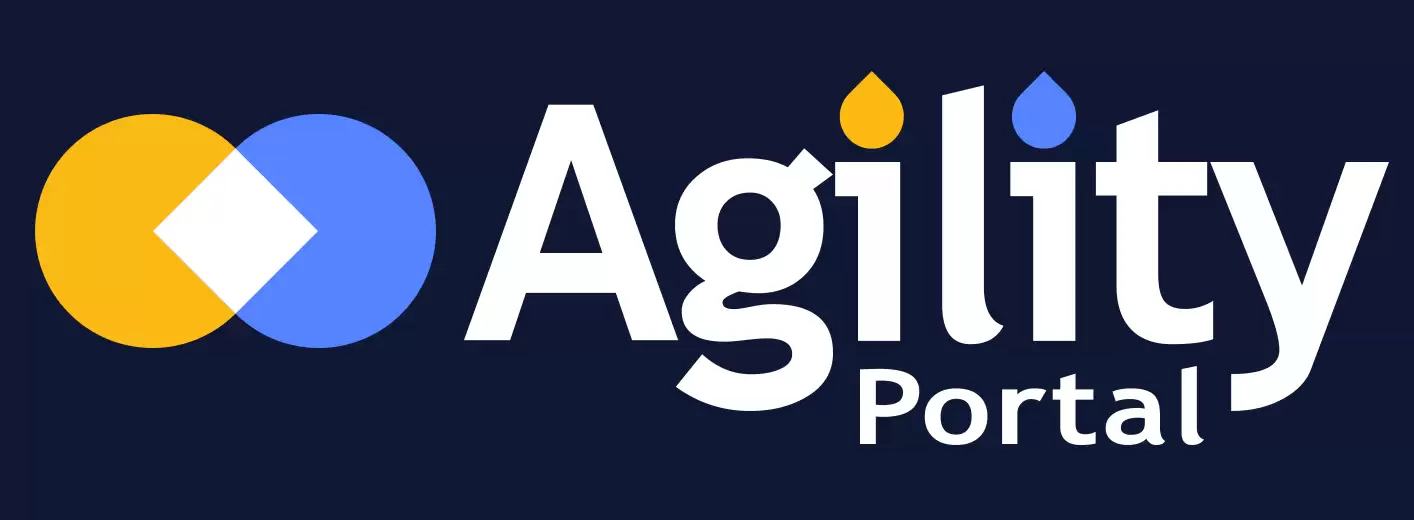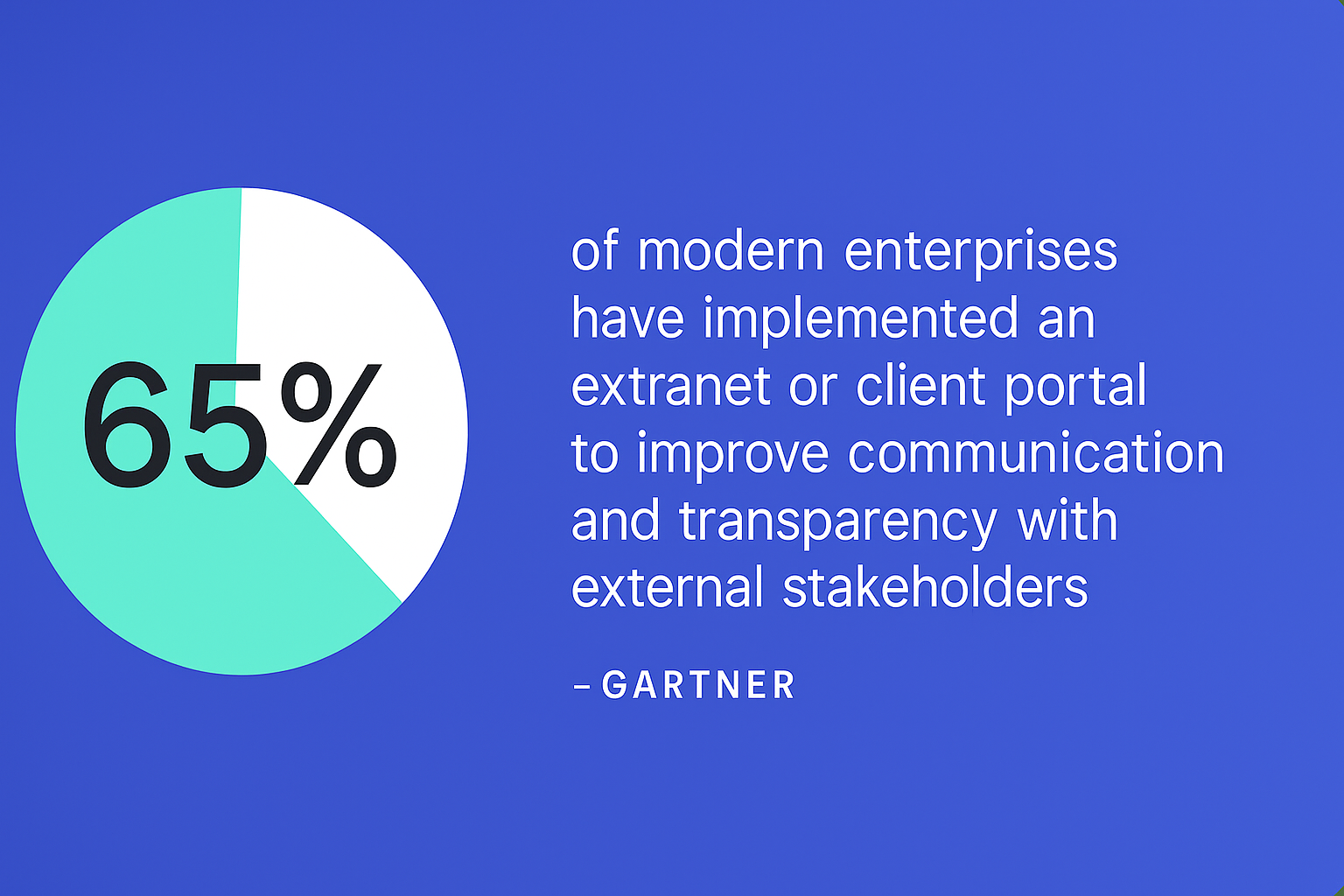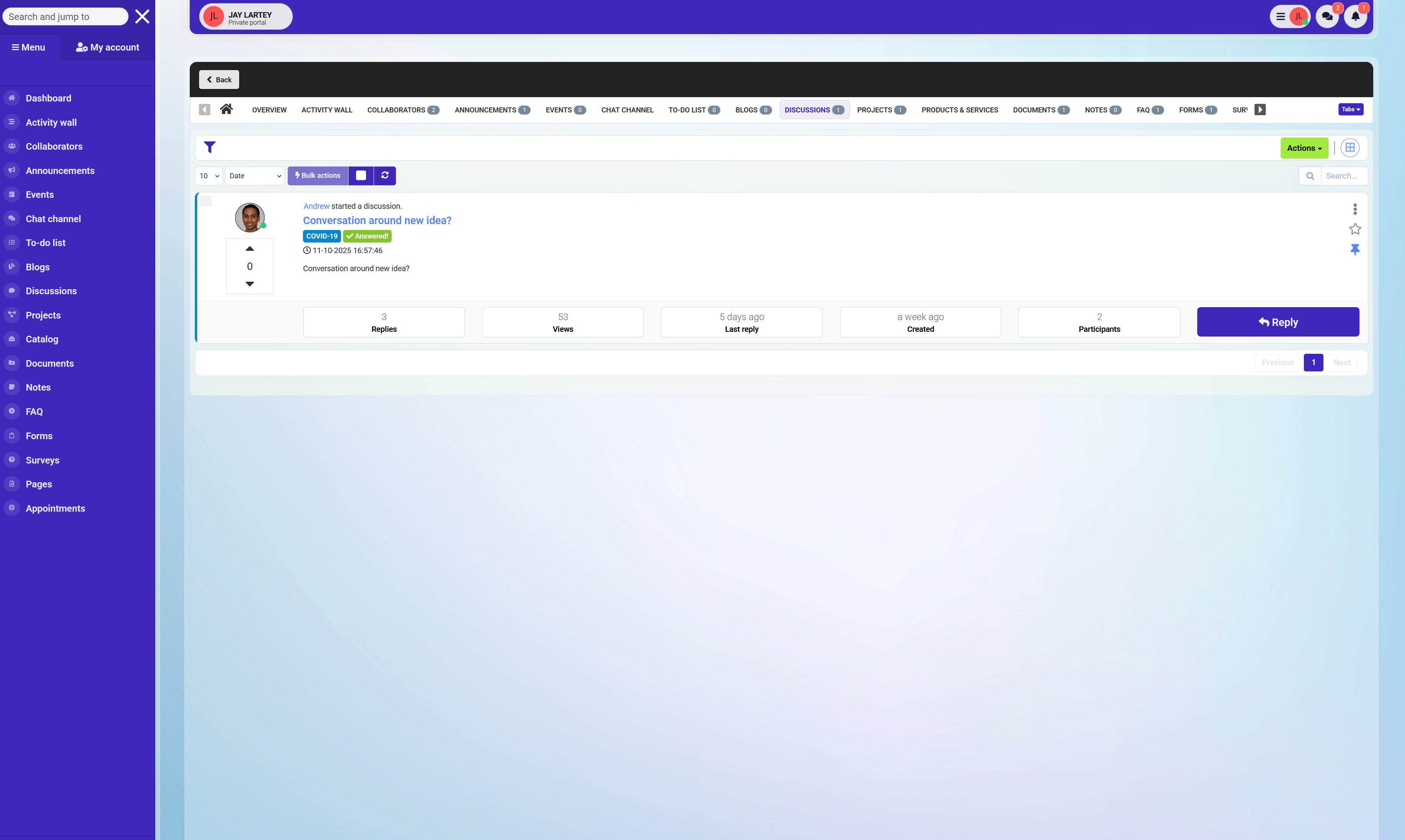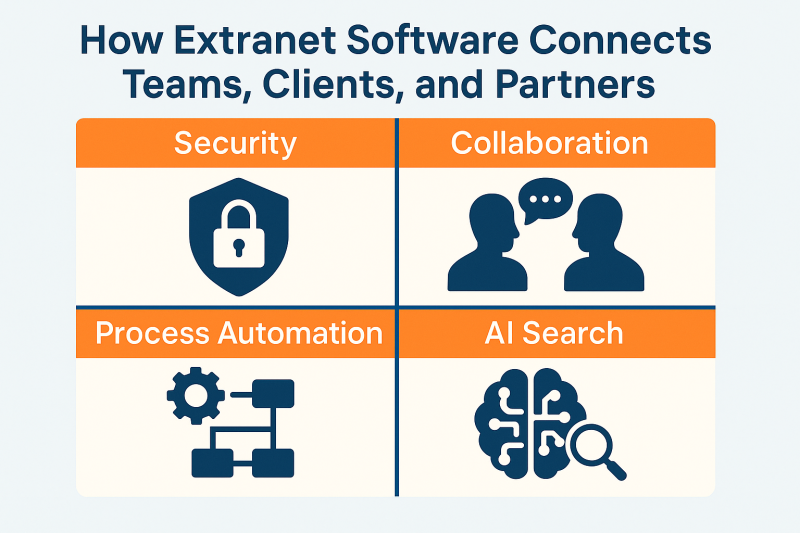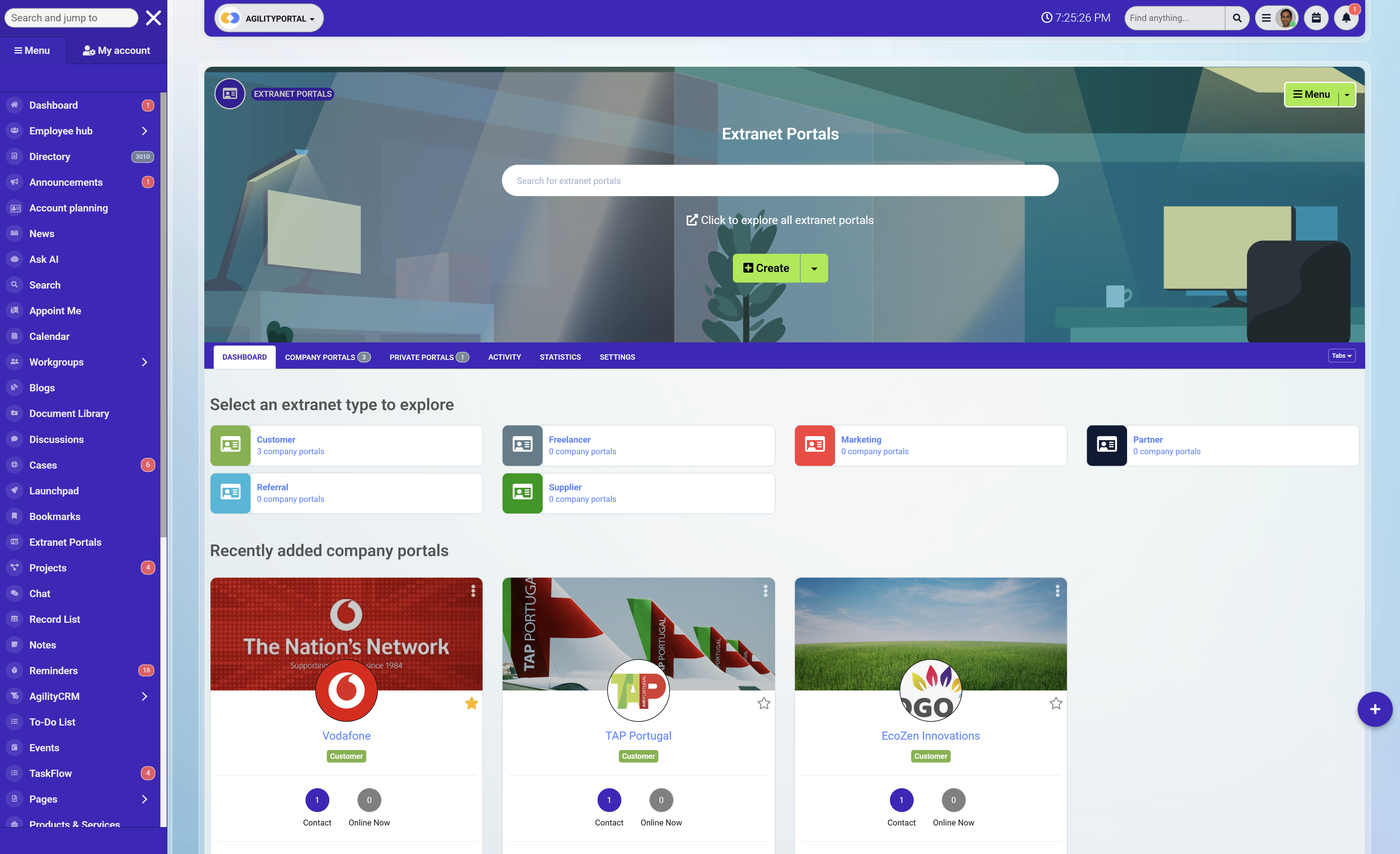Insight Blog
Agility’s perspectives on transforming the employee's experience throughout remote transformation using connected enterprise tools.
18 minutes reading time
(3532 words)
Extranet Software Secrets: How Top Companies Build Stronger Client Relationships Without Email Overload
Extranet Software Secrets: How Top Companies Build Stronger Client Relationships Without Email Overload
Discover how extranet software helps top companies boost client relationships, cut email clutter, and collaborate securely across teams and partners.
In today's hyper-connected business world, sharing information securely with clients, partners, and vendors is no longer a luxury — it's a necessity. That's where extranet software comes into play.
By definition, an extranet is a private digital network that allows an organization to securely collaborate and share information with external users such as customers, suppliers, or stakeholders.
This extranet definition positions it as an extension of a company's internal systems — designed to connect external audiences without exposing sensitive data.
To understand it clearly, let's look at extranet vs intranet. While an intranet focuses on connecting employees within an organization — enabling internal communication, HR updates, and document sharing — an extranet takes that collaboration a step further.
It extends selected resources beyond company boundaries, allowing approved external users to access, upload, and interact with data safely in real time.
Essentially, an extranet acts as a digital bridge between your business and your external collaborators, breaking down silos and simplifying multi-organization workflows.
It's the perfect tool for businesses that work closely with partners, clients, or contractors and need to exchange information efficiently while maintaining strict access control.
According to Gartner, more than 65% of modern enterprises have implemented an extranet or client portal to improve communication and transparency with external stakeholders.
With cloud-based solutions like AgilityPortal, companies can now deploy a branded, no-code extranet in just minutes — empowering external users to collaborate securely while maintaining full data control.
In short, the extranet vs intranet distinction boils down to reach: the intranet serves your internal team, while the extranet opens the door for trusted external collaboration — all within a unified digital workplace.
What Is Extranet Software?
At its core, extranet software is a secure online platform that enables businesses to connect and share information with external stakeholders — including clients, vendors, suppliers, or strategic partners.
The official extranet definition describes it as a private digital network that acts as a controlled extension of a company's internal systems, allowing selected external users to collaborate within a secure environment.
This makes extranets the digital bridge between organizations and the outside world — connecting data, communication, and workflows without compromising security.
When comparing extranet vs intranet, the key difference lies in accessibility and audience. An intranet is built for internal communication — helping employees access company policies, HR updates, and documents.
An extranet, on the other hand, extends this functionality outward, enabling external partners to access shared files, track projects, or manage orders securely.
Your customers today demand faster actions, instant visibility, and smooth experiences. That doesn't just mean engaging directly with them — it also requires your employees, suppliers, and partners to stay connected in real time.
Technological innovations have made this possible through robust extranet solutions that centralize communication, document sharing, and approvals. But it can only happen effectively — and securely — when proper access controls and authentication are in place inside a digital workplace.
In practice, extranet software allows you to:
- Grant partners or clients access to specific folders, dashboards, or reports.
- Share project timelines and updates across organizations.
- Enable secure file uploads and version tracking with full audit trails.
- Integrate existing systems like CRM, ERP, or inventory platforms for seamless collaboration.
An extranet acts as your company's secure digital front door — a place where your external stakeholders can interact with your business just as efficiently as your internal teams do.
Examples of extranet software in action include:
- A logistics company providing real-time shipment tracking for distributors and customers.
- A consulting firm using a client portal to share reports, contracts, and project updates.
- A university giving students and partner institutions controlled access to research materials and academic data.
- A manufacturing brand allowing suppliers to update stock levels or review production timelines.
Platforms like AgilityPortal make this even simpler with a no-code, AI-powered extranet that can be deployed in just minutes — connecting employees, customers, and partners in one unified, secure environment.
In short, an extranet transforms how organizations collaborate, bridging internal operations with external relationships — faster, smarter, and safer than ever before.
What Can an Extranet Do for Your Business?
Probably a lot more than you think.
Modern extranet software unlocks a whole new level of collaboration, communication, and connection between your organization and the outside world.
Creating a digital workspace that extends beyond internal teams requires a mindset shift — one that embraces openness, transparency, and innovation.
With the right platform, your extranet can become far more than just a file-sharing hub; it can evolve into a dynamic ecosystem that connects employees, customers, and partners in meaningful ways.
Organizations use extranets to address a wide range of business needs, including:
At AgilityPortal, we understand that every business evolves — and your extranet should evolve with you. Our customer success team works closely with clients to ensure their platform grows alongside their needs.
With AgilityPortal's AI-powered extranet, you can communicate across your entire external network effortlessly. Personalize content using dynamic audience segmentation, build communities across regions and departments, and empower users with in-platform customization so they can control what they see and how they interact.
Whether users are in the office, in the field, or working remotely, AgilityPortal's mobile app and AI-powered search ensure everyone stays connected, informed, and productive — anytime, anywhere.
In short, an extranet isn't just an external communication tool — it's a strategic extension of your digital workplace, designed to strengthen relationships, accelerate innovation, and future-proof collaboration.
Key Features of Extranet Software
Modern extranet software has evolved far beyond basic file sharing.
Today's platforms are modular, flexible, and intelligently designed to support every aspect of external collaboration — from communication and content sharing to commerce and customer engagement.
Each module can be activated as your business grows, allowing you to customize your extranet into a truly connected digital workplace ecosystem that serves clients, partners, and teams alike.
Here's what a powerful, modern extranet can include:
- Modular Design: Activate or deactivate features based on your business needs — start small with communication tools and expand into content management, e-signature workflows, and e-commerce as your extranet evolves.
- Announcements & Events: Keep everyone informed with company updates, product launches, and scheduled events directly within the platform.
- Chat Channels & Discussions: Facilitate real-time conversations or create threaded discussions with answers and voting options to encourage collaboration and knowledge sharing.
- Blogs & Articles: Publish updates, best practices, and industry insights to keep partners and clients engaged.
- Product & Service Showcases: Present your offerings in interactive galleries, complete with purchase options — turning your extranet into a secure digital storefront.
- Documents with e-Signature: Share proposals, contracts, and reports for quick approval and legally binding e-signatures.
- Notes & Knowledge Pages: Build an internal knowledge hub where users can store ideas, updates, and best practices.
- FAQs & Information Pages: Provide easily accessible answers to common questions, reducing repetitive requests and support tickets.
- Forms & Data Collection: Create custom forms to gather information, onboard partners, or collect customer details directly from the portal.
- Surveys & Feedback: Collect insights and measure satisfaction with built-in survey tools to continuously improve your services.
- Appointment Booking System: Let clients or partners schedule meetings, demos, or consultations directly through your extranet — without third-party tools.
- AI-Powered Search: Instantly find files, messages, or data across the platform — making navigation intuitive and fast for every user.
When combined, these capabilities create a comprehensive, client-centric environment where communication, collaboration, and commerce coexist seamlessly.
With a modular extranet solution like AgilityPortal, organizations can deliver secure, branded digital experiences that evolve as business needs change — all without writing a single line of code.
The Business Benefits of an Extranet
A well-designed extranet can completely transform how your organization collaborates beyond its walls.
By connecting employees, partners, suppliers, and customers in one secure environment, you break down communication barriers and build stronger, more transparent relationships.
While the idea of giving external users access to your internal ecosystem might feel counterintuitive at first, the results speak for themselves.
Modern extranet software allows businesses to share the right information with the right people — securely and efficiently — helping teams innovate faster, eliminate bottlenecks, and improve overall performance.
Below are some of the most valuable benefits organizations gain when implementing an extranet:
1. Accelerated Customer Collaboration
An extranet transforms how your business interacts with external stakeholders — suppliers, clients, investors, and partners.
By providing a centralized, secure environment for communication, you reduce delays and keep every project on track.
Business Value: Faster decision-making, improved accountability, and greater operational visibility.
Key Features:
- Centralized collaboration hubs for projects and partnerships
- Secure document and data sharing in real time
- Threaded discussions and Q&A forums for quick resolutions
2. Faster Time-to-Market and Innovation
Speed is the new competitive edge.
By connecting suppliers and internal teams within one digital workspace, an extranet helps accelerate production, eliminate bottlenecks, and bring new products to market faster.
Business Value: Shorter product cycles, reduced costs, and improved responsiveness to market demands.
Key Features:
- Centralized project spaces and shared tasks,
- Onboarding and checklist
- Real-time version control for product specs and updates
- Integrated feedback channels with suppliers and clients
3. Reliable, Real-Time Information Access
A single, accurate source of truth ensures every stakeholder — internal or external — operates from the latest data.
Whether it's pricing, compliance updates, or inventory levels, an extranet provides instant, accurate visibility.
Business Value: Reduced errors, higher compliance accuracy, and improved data-driven decision-making.
Key Features:
- Live dashboards and status reports
- Automated alerts and change notifications
- AI-powered search to retrieve documents instantly
4. Enterprise-Grade Security and Governance
In a world of rising cyber risks, protecting business data is non-negotiable.
Extranet platforms offer controlled access with encryption, multi-factor authentication, and granular permissions — ensuring sensitive data stays protected.
Business Value: Compliance assurance, reduced data breach risk, and trusted external collaboration.
Key Features:
- Role-based permissions and user authentication
- Encrypted data transfers and audit trails
- Secure e-signature tools for contracts and agreements
5. Operational Efficiency and Cost Savings
Every minute counts — and inefficiencies cost money.
Extranets streamline repetitive processes, reduce email overload, and eliminate manual file sharing. The result is faster communication and less administrative burden.
Business Value: Reduced overhead costs, streamlined workflows, and improved staff productivity.
Key Features:
- Integrated CRM and ERP connections
- Online forms and automated data collection
- Digital surveys for real-time client feedback
6. Elimination of Information Silos
Disconnected communication systems lead to missed opportunities and inconsistent messaging.
An extranet unifies content, communication, and documentation under one roof — creating a single source of truth for your entire ecosystem.
Business Value: Improved alignment between departments, vendors, and clients; reduced miscommunication and data duplication.
Key Features:
- Unified search and centralized document repository
- Intelligent tagging for easier navigation
- Multi-company collaboration spaces
7. Improved Customer Experience and Transparency
Customers want visibility — not voicemail.
An extranet gives clients real-time access to their projects, orders, and service updates, building trust through transparency.
Business Value: Higher customer satisfaction, stronger retention, and reduced support workload.
Key Features:
- Secure self-service portals for clients
- Order tracking, project updates, and support documentation
- Appointment booking and direct communication channels
8. Recognition, Engagement, and Retention
An extranet can also enhance partner and employee engagement.
By showcasing achievements, milestones, and contributions, it fosters a culture of recognition and collaboration that strengthens long-term relationships.
Business Value: Increased loyalty, improved morale, and stronger partnerships.
Key Features:
- Recognition badges and milestone tracking
- Personalized dashboards for performance insights
- Community spaces for sharing success stories
For executives, the real question isn't why implement an extranet — it's how fast. The measurable ROI lies in faster delivery, smarter collaboration, and reduced costs.
A modular, AI-powered solution like AgilityPortal enables businesses to build secure, branded extranets that evolve with their needs — connecting every client, partner, and supplier in one seamless, digital workspace.
Whether you're looking to reduce friction across your supply chain, improve client satisfaction, or increase your team's productivity, the business benefits of an extranet speak for themselves: faster, safer, smarter growth.
Pros and Cons of Using an Extranet
Advantages of an Extranet
Implementing an extranet can bring a wide range of benefits to any organization that collaborates with clients, vendors, or partners.
One of the biggest advantages is the rapid and secure exchange of data between internal teams and external stakeholders. Large files and information can be shared instantly, allowing business processes to run faster and more efficiently.
By replacing manual communication methods — such as emailing individual clients with order updates — an extranet automates key workflows. Customers can simply log into the platform to view their current order status or download relevant documents. This not only saves time but also reduces administrative workloads and minimizes the risk of human error.
Companies also benefit from lower operational costs, as extranets eliminate the need for separate EDI software and reduce manual data handling. The outcome is improved productivity, higher data accuracy, and a smoother customer experience — all of which contribute to long-term profitability and stronger client relationships.
In summary:
- Enables fast, secure data exchange
- Reduces manual processes and errors
- Lowers operating and communication costs
- Improves transparency and customer satisfaction
- Boosts productivity through real-time collaboration
Disadvantages of an Extranet
Despite the clear benefits, there are also some challenges and costs associated with implementing an extranet.
The initial investment for the platform, setup, and customization can be significant — especially for large organizations. Beyond deployment, there are ongoing expenses related to maintenance, security updates, and technical support.
An extranet also requires proper training and change management to ensure employees and external users know how to use it effectively. This can temporarily slow down operations and lead to opportunity costs while staff adapt to new systems.
Security is another key consideration. Because extranets connect external parties to your internal network, maintaining high security standards is essential. Regular audits, encrypted connections, and role-based permissions are needed to protect against unauthorized access — both externally and internally.
In summary:
- Requires upfront investment and maintenance costs
- Demands user training and ongoing technical support
- Carries potential security risks if not properly managed
- May lead to short-term productivity loss during implementation
In short, the advantages of an extranet — such as faster communication, cost efficiency, and stronger collaboration — often outweigh the drawbacks, provided the system is implemented securely and supported by a strong governance framework.
Read this article: : Top 6 AI-Powered Project Management Tools To Use In 2023
Extranet Case Studies
Use Case 1: Construction Company – Streamlining Project Collaboration
A mid-sized construction firm was struggling to coordinate multiple subcontractors and suppliers across various job sites. Project updates were shared through endless email threads, resulting in miscommunication, outdated files, and costly delays.
With AgilityPortal's extranet, the company created secure project portals where subcontractors, engineers, and clients could access real-time updates, upload drawings, and sign documents digitally.
Permissions were managed per role, ensuring sensitive files stayed protected. The result? Faster decision-making, zero version confusion, and projects delivered on time.
Use Case 2: Professional Services Firm – Enhancing Client Transparency
A consulting firm needed a better way to share reports, proposals, and project updates with its clients. Using email made it difficult to track feedback and maintain version control, leading to inefficiency and client frustration.
By implementing AgilityPortal's client extranet, each client received access to a personalized portal for documents, meeting notes, and timelines.
Built-in chat channels and discussion boards kept communication centralized, while AI-powered search made it easy to find any file instantly. Clients appreciated the transparency, and consultants saved hours every week on admin tasks.
Use Case 3: Retail & Supply Chain – Improving Vendor Communication
A retail chain with multiple suppliers was facing challenges with inventory visibility and purchase order tracking.
Email-based coordination led to missed updates and supply inconsistencies.
The organization used AgilityPortal's vendor management extranet to connect suppliers and logistics partners in one hub.
Vendors could update stock levels, confirm deliveries, and access documentation — all in real time. Built-in alerts notified teams when inventory dropped below thresholds, ensuring smooth supply chain operations and significant time savings.
Ready to connect, collaborate, and grow smarter?
Start building the best extranet software tailored to your organization's needs.
The path to true digital transformation begins with the right platform — one that unites teams, clients, and partners securely in one place.
Whether you're streamlining client communication or improving project visibility, AgilityPortal makes it effortless.
Get in touch with our experts today and take the first step toward transforming how your organization collaborates — faster, safer, and more efficiently than ever.
Wrapping up
Extranet software is no longer a "nice-to-have" — it's a strategic necessity for any organization that collaborates with external stakeholders.
It improves efficiency, strengthens client relationships, and keeps communication secure — all while reducing administrative overhead.
If you're ready to simplify how your company shares information and collaborates externally, explore AgilityPortal — the all-in-one intranet and extranet platform that combines AI-powered search, secure collaboration, and no-code setup in one seamless experience.
Frequently Asked Questions (FAQ)
1. What is client collaboration software and how does it benefit businesses?
Client collaboration software allows businesses to communicate, share files, and manage projects with clients in real time. It helps reduce email clutter, improve transparency, and strengthen client relationships.
With platforms like AgilityPortal, you can centralize communication, manage feedback efficiently, and enhance overall client satisfaction.
2. What makes a secure extranet portal important for modern organizations?
A secure extranet portal provides a private online space where your company can safely collaborate with external stakeholders — clients, vendors, and partners.
It ensures controlled access, encrypted communication, and compliance with data protection standards, making it essential for industries that handle sensitive information.
3. What is a no-code client portal builder?
A no-code client portal builder lets you create a custom client or partner portal without needing to write a single line of code.
Businesses can easily design dashboards, workflows, and document-sharing spaces using drag-and-drop tools — saving time and development costs while maintaining full flexibility.
4. How does an enterprise collaboration platform improve productivity?
An enterprise collaboration platform brings together internal and external communication tools — chat, file sharing, tasks, and meetings — into one unified workspace.
It helps employees and partners collaborate seamlessly, reducing miscommunication and improving decision-making across departments.
5. What are the best practices for document sharing for businesses?
Document sharing for businesses should prioritize security, version control, and accessibility. Use encrypted cloud storage, restrict access based on roles, and ensure real-time collaboration.
Platforms like AgilityPortal make document sharing fast, secure, and fully auditable for compliance purposes.
6. What is a digital client management system?
A digital client management system centralizes all client interactions — from onboarding to ongoing support — in one digital hub.
It helps track communications, manage contracts, and deliver personalized service, improving client retention and operational efficiency.
7. How does B2B communication software improve collaboration with partners?
B2B communication software streamlines collaboration between companies by offering shared workspaces, secure messaging, and project tracking.
This reduces email overload and improves response times, helping both parties stay aligned on goals and deliverables.
8. What are extranet solutions for organizations used for?
Extranet solutions for organizations enable secure collaboration between a business and its external partners, clients, or suppliers.
They are ideal for project management, document exchange, and workflow automation — all within a controlled and compliant environment.
9. How do AI-powered extranet tools enhance communication and efficiency?
AI-powered extranet tools automate routine tasks such as data entry, report generation, and content recommendations.
They also provide insights into collaboration patterns, helping teams improve productivity and identify areas for optimization.
10. What are the benefits of cloud-based partner portals?
Cloud-based partner portals allow companies to manage partner relationships securely from anywhere.
They enable file sharing, onboarding, deal tracking, and real-time collaboration — all powered by scalable cloud infrastructure that ensures high availability and performance.
Categories
Blog
(2588)
Business Management
(318)
Employee Engagement
(204)
Digital Transformation
(172)
Intranets
(119)
Growth
(117)
Remote Work
(61)
Sales
(48)
Collaboration
(37)
Culture
(29)
Project management
(29)
Customer Experience
(26)
Knowledge Management
(21)
Leadership
(20)
Comparisons
(5)
Ready to learn more? 👍
One platform to optimize, manage and track all of your teams. Your new digital workplace is a click away. 🚀
Free for 14 days, no credit card required.
